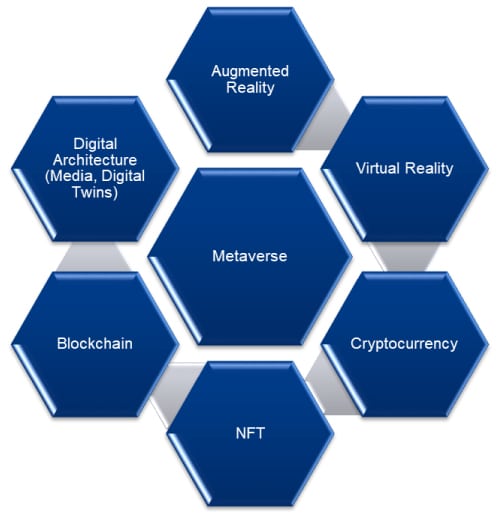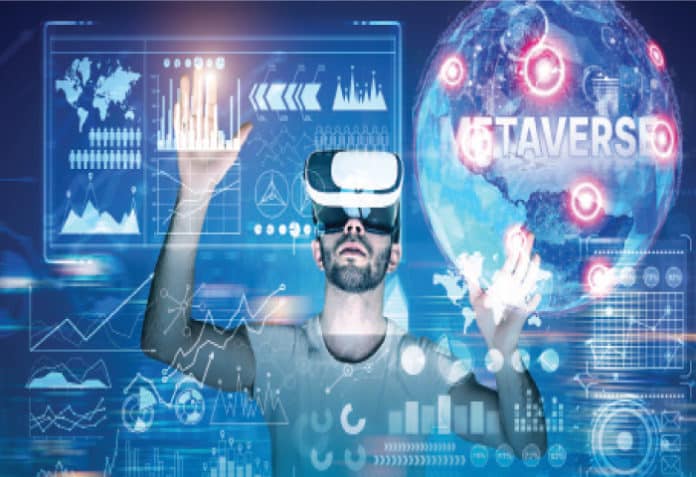There is a lot of hype about the metaverse today. However, it is critical to understand how the metaverse can help incorporate innovative solutions to offer a better customer experience, simplify IT operations, and introduce new age business models. And it’s also important to know what technologies together make up the metaverse.
As per a Gartner report, by the year 2026, at least 25 per cent of the world’s population will be immersed in activities in the metaverse (shopping, work, virtual class, social media and entertainment). Forrester’s ‘The State of Metaverse: Look Beyond the Hype to Uncover the Real Opportunities’ report claims that more than 50 per cent of all internet users will be early adopters of the metaverse.
Hyperreal world and metaverse
Hyperreality is a concept that has been in use for more than a decade, where users are made to believe to live in a virtual world. One such classic example is the live shows in Disney World (e.g., Peter Pan) which make you believe you are in that world and you forget the real world. These 3D, 4D and 5D shows use spatial, modelling and immersive technologies.
Hyperreality applications use generative AI algorithms and visual effects like sound, touch sense and real-world objects to create synthetic content which can take users into a virtual world. This kind of synthetic content leads to the development of metaverse platforms through SDK and AI services.
From an architect’s perspective, synthetic content in hyperreality, digital twins with avatars, and AI generative algorithms for model development have all led to metaverse’s success. A unified platform, which combines agility, scalability and reliability through cloud platforms, virtual transaction management through NFTs and blockchain platforms, and immersive technology through human interactive devices can help to build a robust metaverse.
The technologies that make the metaverse
Let’s take a look at the technologies that have come together to make the metaverse.
Virtual reality (VR) and augmented reality (AR): While the metaverse is a platform that is still developing, virtual reality is a technology that is already being used in daily lives. (The metaverse may even replace the internet as we know it today.) Virtual reality can be experienced today in diverse real-time applications like simulators, gaming, Industry 4.0, etc. Metaverse can be experienced via VR and AR. Metaverse technology is far more advanced than virtual reality and is expanding to 3D depiction of the internet or virtual world.
Blockchain and cryptocurrency: ‘Crypto metaverses’ have a huge social and financial potential, and enable the integration of blockchain infrastructure with the metaverse virtual world. With the fusion of virtual environments using VR, games, social media networking and crypto exchanges, the metaverse could become a ‘central element’ for the next level of blockchain gaming.
Crypto metaverse is defined as a metaverse that integrates blockchain technology and crypto assets such as ‘metaverse tokens’. Examples of crypto metaverses are: Decentraland, The Sandbox, Aliens World and Cryptovoxels. With VR, blockchain, and crypto, the gaming industry can experience a revolution that can be called ‘blockchain gaming’. Metaverse crypto assets include digital objects, land, etc, details of which can be recorded on a blockchain and even traded using Bitcoins or Ether on diverse decentralised exchanges (DEXs).
Key features:
- Decentralisation: Crypto metaverses are decentralised, giving all metaverse games developed on blockchain technology strong value models.
- Provable provenance: Crypto tokens called non-fungible tokens (NFTs) will enable transparency and access to asset markets in the gaming industry.
- Real-world economic value: Metaverse tokens can be exchanged on DEXs and NFT marketplaces.
Artificial intelligence: Fusion of artificial intelligence (AI) with the metaverse adds value to infrastructure, and gives better information to all the top layers of the metaverse.
Metaverse makes use of AR, VR, AI and blockchain to make advanced replicas of the real world in a virtual world. It applies advanced AI algorithms to perform content analysis, speech processing, computer vision, and more.
This is how the metaverse uses AI.
Virtual avatars: With the use of AI, 2D or 3D user images can be scanned and transformed to very realistic avatars.
Digital humans: Digital humans have human-like capabilities for seeing, listening and understanding the conversation of real humans. They can use digital speech and body language to create human-like conversations. In the metaverse, digital humans can be considered as 3D chatbots that respond just like human beings. They are called ‘non-playing characters’ whose actions and outcomes are measured by automated scripts or sets of rules.
Language processing: With AI, all languages can be transformed to a machine readable format that is analysed, and the output is generated back in the same language. By using advanced ML and DL (deep learning) algorithms, language translation becomes more accurate and fast in response.
Data learning: AI helps generate models into which historical data is fed. DL and ML are used to generate new outputs, and as more and more data is fed into the model, the outputs get better.
3D graphics: Metaverse is also dependent on 3D technologies. 3D graphics generate images or objects using 3D graphics software. These can be viewed using specialised hardware called 3D displays, and have diverse applications in the real world.
3D reconstruction is a technology that uses 3D models to visualise an object or environment in a three-dimensional view. The metaverse can only exist within the three-dimensional setting. It’s essentially a digital twin of our world.
Meta has rolled out diverse devices like Oculus VR to experience the metaverse.3D graphics: Metaverse is also dependent on 3D technologies. 3D graphics generate images or objects using 3D graphics software. These can be viewed using specialised hardware called 3D displays, and have diverse applications in the real world.
3D reconstruction is a technology that uses 3D models to visualise an object or environment in a three-dimensional view. The metaverse can only exist within the three-dimensional setting. It’s essentially a digital twin of our world.
Meta has rolled out diverse devices like Oculus VR to experience the metaverse.
The Internet of Things: IoT technology provides a strong bridge between the physical and virtual worlds. It helps analyse data from the physical world using smart sensors. IoT and the metaverse can together take smart systems to the next level.
Metaverse can leverage IoT in the following ways.
‘Real’ feeling in devices: Via IoT, the metaverse can make virtual devices look real, and even solve complex problems of hybrid data integration with cloud and digital infrastructures.
Smart integration: IoT can help the metaverse collaborate with the real world. It is a strong building block for creating interoperable systems and fusing digital content into the physical environment.
Data collection: IoT enables digital twins and virtual simulations in the metaverse. It helps integrate scanned objects with real metadata from the physical environment.

Universal scene description (USD) for metaverse development
When there are multiple metaverse platforms, there are no uniform technology solutions on how to develop the metaverse platform and the 3D objects in it. Pixar was using universal scene description (USD) for a long time to describe 3D objects, and open sourced it in 2016. Now, for metaverse platform development, many companies like Adobe, NVIDIA, Siemens and Lowe’s have started looking into USD as the standard solution for metaverse-based 3D object rendering and development.
Initially, when Pixar used USD, it did so mainly for media related image rendering in the 3D space, in the entertainment sector. We can now expect more real-time use cases across different sectors like medical and healthcare, robotics and retail. USD is more than animation and simulation of real-world objects — it enhances the immersive experience for end users through its 3D rendering.
When USD grows in the metaverse world as a standard facility, Forrester predicts that growth and standardisation of the four technologies listed below can elevate the growth of the metaverse.
Extended reality (XR) is a combination of VR, AR and mixed reality (MR). The continual convergence of these technologies will enhance the immersive user experience.
Web 3.0 will enable delivery of next-generation web technology solutions. NFTs and secured blockchain based network solutions will help create resilient, high performing and secure platforms for metaverse based cryptocurrency transactions.
Zero Trust Edge (ZTE) will provide seamless and uninterrupted network facilities for metaverse solutions. It will combine high performance in network communications with zero or low latency and have embedded security features.
TuringBot is a term coined by Forrester for automatic and autonomous code development and testing automation. It can solve problems and develop solutions based on in-built AI-powered software.
Token economy and metaverse solutions
We have been hearing about NFTs and cryptocurrencies in recent times, but they are misconceptualised as an investment option and are interchangeable. There is also a thin line drawn between Web 3.0, token economy and digital currencies in association with NFTs and cryptocurrencies. It is better to understand each of them to understand how and when to use them.
Token economy refers to a digital transformation process using blockchain technology, where physical assets are digitised and processed in a blockchain platform for online trading. In simple terms, blockchain platform enables token economy models using cryptocurrency tokens. Smart contracts are used to programmatically define how tokens can be managed, exchanged and realised in a blockchain platform.
Industrial metaverse
According to a report from Market Prospects, the industrial metaverse is expected to touch US$ 540 billion in revenue by 2025.
The industrial metaverse prepares current industrial infrastructure for digital transformation. It gives a central platform for companies, offering security, easy accessibility and usability.
Industrial metaverse integrates all processes and applications, bringing everything under a single roof, and making it transparent and manageable.
Companies can fully utilise and leverage the potential of industrial metaverse in the following ways:
- Brand awareness via factory walks and virtual interactions
- Virtual presentations of all sorts of products and services
- Payment via blockchain/NFTs or metaverse’s crypto
- R&D collaborations using digital twins for design, simulation and testing of new products
- Strong feedback services using customer’s voice
The industrial metaverse is still at an infant stage, and it faces challenges because of high equipment costs and technical difficulties.
The idea of an industrial metaverse has attracted a great deal of interest over the last 12 months. It describes, in short, a highly immersive and connected virtual and physical reality enabling never-before-seen levels of intelligent connectivity and AI.










































































